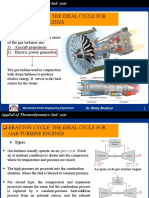Quiz 1 Statement
Quiz 1 Statement
Uploaded by
sanjeeviaq6873Copyright:
Available Formats
Quiz 1 Statement
Quiz 1 Statement
Uploaded by
sanjeeviaq6873Copyright
Available Formats
Share this document
Did you find this document useful?
Is this content inappropriate?
Copyright:
Available Formats
Quiz 1 Statement
Quiz 1 Statement
Uploaded by
sanjeeviaq6873Copyright:
Available Formats
22.
312
ENGINEERING OF NUCLEAR REACTORS Tuesday, October 16th, 2007, 2:30 4:00 p.m.
OPEN BOOK
QUIZ 1
1.5 HOURS
Problem 1 (55%) - Nuclear cogeneration plant
A High-Temperature Gas Reactor (HTGR) is being considered for cogeneration of electricity and heat for residential heating. This HTGR uses the direct Brayton cycle shown in Figure 1, which comprises a turbine, a regenerator, a cogeneration heat exchanger (34) and a compressor. The cogeneration heat exchanger is used to generate steam, which is then sent to the residential area served by the plant. The helium temperature and pressure at the turbine inlet are 1000 K and 9 MPa, respectively. The minimum temperature in the cycle is 373 K. The cycle operates with a compression ratio equal to 2. The isentropic efficiency for the turbo-machines (turbine and compressor) is 0.9. Assume negligible pressure losses throughout the cycle.
Reactor 6 1
Turbine 5 Compressor Regenerator Cogeneration heat exchanger 4 3 2
Return water
Steam to residential heating system
Figure 1. Schematic of the nuclear cogeneration plant. i) Sketch the T-s diagram for the cycle. (5%) ii) An important parameter to select is the cogeneration temperature T3. If T3 is too high, regeneration is minimal and the cycle thermal efficiency becomes too low. If T3 is too low, the amount of heat delivered to the residential heating system may be too low. Find the value of T3 that will give a cycle thermal efficiency equal to 30%. (30%) iii) What is the energy utilization factor (EUF) of this cycle? The EUF is defined as the ratio of the energy utilized (net work + cogeneration heat) to the heat input (reactor heat). (5%)
Cite as: Jacopo Buongiorno, course materials for 22.312 Engineering of Nuclear Reactors, Fall 2007.
MIT OpenCourseWare (http://ocw.mit.edu/), Massachusetts Institute of Technology. Downloaded on [DD Month YYYY].
iv) What is the reactor thermal power if the plant is to produce 100 kg/s of saturated steam at 0.5 MPa from the return water at 80C? (10%) v) Nuclear cogeneration for residential heating has been rarely done. What are in your opinion the drawbacks of this approach? (5%) Useful properties Helium: Treat as an ideal gas with cp= 5193 J/kg-K, R=2077 J/kg-K, =1.667. Water at 0.5 MPa (Tsat=152C): specific heat = 4.24 kJ/kg-K, enthalpy of vaporization = 2109 kJ/kg
Cite as: Jacopo Buongiorno, course materials for 22.312 Engineering of Nuclear Reactors, Fall 2007.
MIT OpenCourseWare (http://ocw.mit.edu/), Massachusetts Institute of Technology. Downloaded on [DD Month YYYY].
Problem 2 (45%) Pressure rise in a BWR suppression pool during a LOCA
In a BWR containment the steam discharged from the reactor during a Loss of Coolant Accident (LOCA) is directed to and condensed in a large suppression pool (Figure 2). The free volume above the water in the pool (i.e., the so-called wet well) is sealed tight and filled with nitrogen gas. The wet well is equipped with a safety/relief valve that opens at 0.68 MPa.
Steam from reactor Safety/relief valve
Wet well
Liquid level
Figure 2. The BWR suppression pool. i) Assuming that during a large LOCA the rate of steam discharge to the pool is 1000 kg/s (constant in time), write a complete set of equations that would allow you to calculate the time at which the safety/relief valve opens. (35%) ii) Does the liquid level (i.e., height of water) in the pool increase, decrease or stay the same during the LOCA (prior to the safety/relief valve opening)? To get full credit for this question, it is sufficient to list the effects that tend to increase the level and those that tend to decrease the level, and take a guess based on your engineering judgment of the relative importance of such effects. (10%) Data Initial liquid water volume in the pool: 240 m3 Initial volume of nitrogen: 200 m3 Initial relative humidity of nitrogen: 100% Initial temperature of the pool: 30C Initial pressure of the pool: 0.101 MPa (atmospheric) Nitrogen specific heat at constant volume: 742 J/kg-K Nitrogen gas constant: 297 J/kg-K Enthalpy of the steam discharged into the pool: 2600 kJ/kg Assumptions - Steam tables are available - Treat nitrogen as a perfect gas - Thermodynamic equilibrium exists in the suppression pool throughout the accident - Neglect kinetic and gravitational terms - Neglect heat transfer between the pool and the surrounding structures
Cite as: Jacopo Buongiorno, course materials for 22.312 Engineering of Nuclear Reactors, Fall 2007.
MIT OpenCourseWare (http://ocw.mit.edu/), Massachusetts Institute of Technology. Downloaded on [DD Month YYYY].
You might also like
- EgyE 201 Assignment On Energy Conversion SystemsNo ratings yetEgyE 201 Assignment On Energy Conversion Systems2 pages
- Me6301 Engineering Thermodynamics Nov Dec 2011No ratings yetMe6301 Engineering Thermodynamics Nov Dec 20113 pages
- Clean Electricity Production by Solid Oxide Fuel Cell-Waste Heat Recovery Boiler Arrangement in Conjunction With A Gas TurbineNo ratings yetClean Electricity Production by Solid Oxide Fuel Cell-Waste Heat Recovery Boiler Arrangement in Conjunction With A Gas Turbine4 pages
- AE8301 Aero Engineering Thermodynamics, QP, Model (2020 - 2021) - SNo ratings yetAE8301 Aero Engineering Thermodynamics, QP, Model (2020 - 2021) - S2 pages
- Analysis and Perspective On Heat Pump For IndustriNo ratings yetAnalysis and Perspective On Heat Pump For Industri27 pages
- Recovery of CO2 With MEA and K2CO3 Absorption in The IGCC SystemNo ratings yetRecovery of CO2 With MEA and K2CO3 Absorption in The IGCC System15 pages
- Nchu-Che Thermodynamics I: This Question Paper Consists of 3 QuestionsNo ratings yetNchu-Che Thermodynamics I: This Question Paper Consists of 3 Questions3 pages
- Energy: H. Rosyid, R. Koestoer, N. Putra, Nasruddin, A.A. Mohamad, YanuarNo ratings yetEnergy: H. Rosyid, R. Koestoer, N. Putra, Nasruddin, A.A. Mohamad, Yanuar9 pages
- Dheeraj Kishor Johar, Pradeep K Gupta, Vinod Singh Yadav and Dilip Sharma Malaviya National Institute of Technology Jaipur, J.L.N. Marg, 302017, Jaipur, India Corresponding AuthorNo ratings yetDheeraj Kishor Johar, Pradeep K Gupta, Vinod Singh Yadav and Dilip Sharma Malaviya National Institute of Technology Jaipur, J.L.N. Marg, 302017, Jaipur, India Corresponding Author7 pages
- Heat Loss Throughthe Exhaustin Internal Combustion EngineNo ratings yetHeat Loss Throughthe Exhaustin Internal Combustion Engine8 pages
- Module 2-THERMODYNAMICS-problems-2024-sent - Physic1No ratings yetModule 2-THERMODYNAMICS-problems-2024-sent - Physic12 pages
- Thermodynamic analysis of geothermal heat pumps for civil air-conditioningFrom EverandThermodynamic analysis of geothermal heat pumps for civil air-conditioning5/5 (2)
- Designs and Fabrication of Solar Parabolic CollectorNo ratings yetDesigns and Fabrication of Solar Parabolic Collector57 pages
- Energy Conservation in Boiler: A ThesisNo ratings yetEnergy Conservation in Boiler: A Thesis70 pages
- Heat Rate System Analysis in The Steam Power Plant in Niitanasa Using Environmentally Friendly Low-Calorie Fuels (Revisi)No ratings yetHeat Rate System Analysis in The Steam Power Plant in Niitanasa Using Environmentally Friendly Low-Calorie Fuels (Revisi)13 pages
- 50-100 TOP MOST AUTOMOBILE ENGINEERING Multiple Choice Questions and Answers For Competitive Exams - Preparation For GATE Exams Automobile Engineering Multiple Choice Questions PDF83% (6)50-100 TOP MOST AUTOMOBILE ENGINEERING Multiple Choice Questions and Answers For Competitive Exams - Preparation For GATE Exams Automobile Engineering Multiple Choice Questions PDF7 pages
- p2016.03.003.pdf.25 - Wpo.a Study On Synthesis of Energy Fuel From Waste Plastic and AssessmentNo ratings yetp2016.03.003.pdf.25 - Wpo.a Study On Synthesis of Energy Fuel From Waste Plastic and Assessment6 pages
- Chapter 8B - Gas Power Plant Brayton Cycle100% (1)Chapter 8B - Gas Power Plant Brayton Cycle17 pages
- Design For Blast Furnace Gas Firing Gas Turbine: (Hereinafter Abbreviated As BFG)100% (1)Design For Blast Furnace Gas Firing Gas Turbine: (Hereinafter Abbreviated As BFG)12 pages
- Second Law Efficiencies and Exergy Change of A SystemNo ratings yetSecond Law Efficiencies and Exergy Change of A System14 pages

























































































